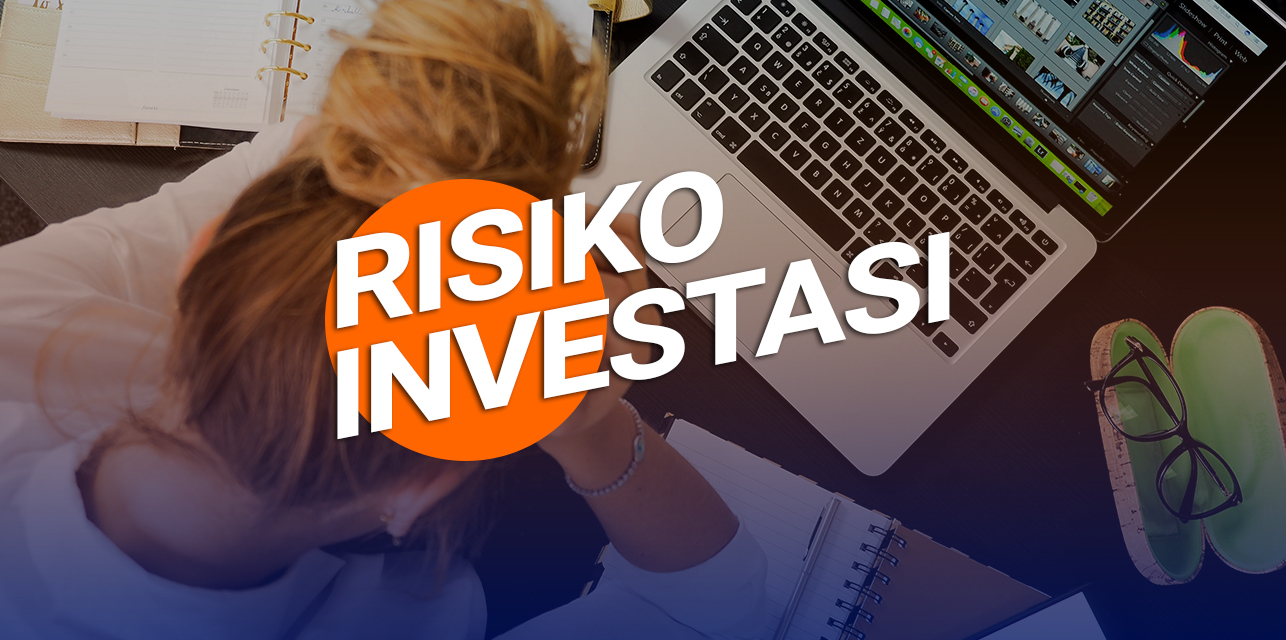Table of Contents
Actually, what is investment risk?
According to the Great Dictionary of the Indonesian Language (KBBI), risk is the unpleasant (detrimental, harmful) consequence of an act or action. Well, in the context of investment, the definition of investment risk is uncertainty that causes the failure to achieve financial or investment goals.
Meanwhile, according to experts, investment risk is a deviation (variability) between expected returns and actual returns.
Simply put, investment risk is a loss experienced by investors in certain elements. Although investment in general always talks about profits, there is still a risk of loss that will occur.
Most high-risk investments have high returns as well. So in conclusion, investment risk is the level of potential losses that arise because the acquisition of investment results is not in accordance with expectations or profit targets.
As an investor, you must be well aware that investments in addition to promising potential profits, can also cause losses. Simply put, in investment there is a strong relationship between investment returns and investment risks. The higher the potential profit, the higher the level of risk, and vice versa.
All types of investments, both gold investments, property investments, and investments in the capital market must have risks. Especially related to risk, each investor has a different tolerance attitude towards investment risks.
Measuring investment risk is important for an investor. Some are comfortable taking risks (risk-takers), some are less daring or hesitant (risk-moderate), and some are completely unwilling to take risks (risk-averse).
There is no single investment instrument that is suitable for everyone. Everyone (investors) needs to recognize their respective investment risk profiles before making investments so that later they will be able to choose the investment instrument that best suits their needs.
The problem is that people or investors often only pay attention to the level of return offered but forget or pay little attention to the level of risk that may be faced if they choose the investment in question. This reality is one of the causes of the increasing prevalence of fraud cases and victims of allegedly illegal investment offers to the public. People are tempted by the promise of investment returns, but do not pay attention to and understand the level of risk.
What are the types of investment risks?
Quoted from the Kontan column written by Harris Hadinata, there are two types of risk in investment, namely systematic risk and non-systematic risk. Systematic risk is all types of risks that are external and cannot be controlled and cannot be avoided. The characteristic of this risk is that it cannot be controlled and affects all effects and cannot be reduced by diversification.
This risk is often called market risk. Some types of systematic risk are interest rate risk, purchasing power risk or inflation, commodity risk and currency risk. The second type of investment risk is unsystematic risk. These risks are controllable or avoidable risks.
This risk can be minimized, even eliminated, by diversifying or forming a portfolio. This risk is also called specific risk or company risk. Some examples are business risk, financial risk, and liquidity risk. What risks do investors face when investing? Here is a detailed explanation.1. Systematic risk
Interest rate risk
The interest rate is the price of borrowing money or the cost of borrowing money, usually expressed in percentages. These interest rates fluctuate over time. Well, Interest rate risk is a risk that arises due to interest rate fluctuations, an example of an investment risk case is a financing investment such as a loan or bond investment.
This type of investment will usually deteriorate due to rising interest rates. This risk is caused by changes in interest rates so that it will affect investment income. For example, if interest rates increase, the price of fixed-rate bonds will fall, and vice versa. Interest rate risk is generally measured by the term of the bond.
For example, the bond interest rate is 8-10%, but then the government issues Retail Sukuk which has an interest rate of up to 12%. That way, investors will prefer this Retail Sukuk. One important consideration is the current interest rate, which is influenced by the interest rate of the Federal Reserve, the U.S. country's central bank that charges other banks to borrow money. The Federal Reserve is usually reactive to the economy and the interest rate environment.
Inflation risk
Inflation risk, or commonly called purchasing power risk, is the opportunity that cash flows from investments will not be worth as much as they are today in the future due to changes in purchasing power due to inflation. This risk has the potential to harm people's purchasing power to investment due to an increase in the average consumption price.
Inflation risk is the risk taken by investors when holding cash or investing in assets that are not related to inflation. The risk is that the value of cash will be reduced by inflation.
For example, if an investor holds 40% of a cash portfolio of IDR 10,000,000 and inflation runs at 5%, the cash value of the portfolio will lose IDR 2,000,000 per year (IDR 10 million x 0.4 x 0.05) due to inflation.
Currency exchange rate risk (forex)
Foreign exchange risk is a risk caused by changes in foreign exchange rates in the market that are no longer in line with expectations, especially when converted into domestic currencies. This type of risk is related to a fluctuation in the rupiah exchange rate against the currency of another country.
In general, this type of risk is also referred to as currency risk or exchange rate risk. For example, an investor wants to invest in an investment that requires him to use the US dollar. At the same time, the rupiah exchange rate against the US dollar is weak, so investors have to spend more rupiah than when the rupiah value strengthens.
Well, the strengthening of the dollar against the rupiah can provide losses. An investment that is closely related to using currency as an asset is forex investment. What are the risks of forex investment during the pandemic? In fact, unlike other investment assets, forex does not experience deep shocks and still benefits traders and investors.
Commodity risk
Commodity risk is the risk caused by changes in the price of a particular commodity due to various factors. This type of risk is related to fluctuations in commodity prices and is influenced by demand and supply. Commodity investments are usually done through futures brokerage firms or brokers.
2. Unsystematic risk
Liquidity risk
Liquidity risk is a risk that arises due to difficulties in providing cash within a certain period of time. For example, a party cannot pay its obligations that are due in cash. This investment risk is often experienced by the banking industry. Even though the party has assets of sufficient value to pay off its obligations, but when the assets cannot be converted immediately into cash, then the assets are said to be illiquid.
This can happen if the debtor is unable to sell his property because there are no other parties in the market who are interested in buying it. This is different from a drastic decline in asset prices, because in the case of price declines, the market thinks that the asset is worthless.
The absence of parties interested in exchanging (buying) assets may only be caused by the difficulty of bringing the two parties together. Therefore, liquidity risk is usually more likely to occur in markets that are just growing or have small volumes.
This type of risk is related to the acceleration of securities issued by the company that can be traded in the secondary market.
Reinvestment risk
This risk is a risk that occurs in income from a financial asset that requires the company to carry out reinvestment activities. So, when you want to reinvest, companies must really understand what reinvest is and how to manage or manage this investment risk.
Financial risk
This risk is related to the funding structure that a company does. The company's source of funding can be from shareholders in the form of common shares or preferred shares, or through short-term or long-term loans.
When a company uses a lot of funding with debt or preferred stocks that tend to have fixed liabilities, then the company is considered riskier. Lending is considered leverage that has two sides. On the one hand, it can increase the company's profits when economic conditions are good. While on the other hand, it can be a risk when the economy deteriorates or is bad.
Anticipating this risk, investors should study a company's liquidity ratio, which shows the company's ability to meet its obligations in the short term. Liquidity problems can cause companies to default which has the potential to cause bankruptcy.
In addition, investors need to study the solvency ratio that shows the company's ability to meet its long-term obligations and all of its obligations. Investors who do not like the risk of investing in stocks, can choose stocks with low leverage.
Business risks
This risk is usually related to the company's business. Usually, companies in one sector with the same business are considered to have the same risk. Therefore, market participants in forming a portfolio should not buy several stocks from the same sector, especially if the company's business is the same.
You should always remember, that there is an influence of investment risk on stock returns, which will ultimately affect profits. Sectors that are affected by cycles such as commodities and property are considered to be more risky than the consumption or pharmaceutical sectors that affect stock returns. Business risks can be reduced by choosing a more defensive sector.
How to prevent investment risks?
Although risk and profit will continue to 'coexist' with investments, it does not mean that you cannot prevent losses. Take mitigation steps to minimize investment risks. Here's the review.
1. Determine investment targets
By setting a clear investment target, you can know a lot of things. Starting from the desired investment period, what type of investment and what company you want to invest in, and also the type of risk you want to take. If you want a short-term investment with little risk, you can try investing in mutual funds while studying the market and other types of investment instruments.
For beginners, it is recommended that you start with a small risk first, even though the return rate is not so large. When you understand the market and the type of investment, then move on to higher risks because there is already basic knowledge about investment and the risks that are in it. That way, you can also learn how to manage investment risk.
2. Regularly supervise investments
After doing your research and deciding what instrument you want to invest in, you should always be in full control of your investment by controlling investment risks and monitoring your investment movements.
This is very necessary to be done regularly so that you do not miss the opportunity when you can withdraw and get high profits, or miss the warning when the investment is in a downtrend. From here, you can learn to better understand how the market works and its dynamics and can do investment risk management.
When market conditions are declining, don't panic and always remember the first point, which is the investment target from the beginning.
3. Beware of scams
One of the biggest risks of investing is fraud. Even though we are wary of scammers and fraudulent investments, many scammers are getting more sophisticated here. They can make themselves look professional and credible, making it difficult to see which ones are true and which are not.
But don't worry, because there is one simple step that you can follow to avoid fraud, which is to see if the company you want to invest in has legality and official permits from the Financial Services Authority (OJK) and Bappebti. This applies to investments as well as third parties who assist with the process such as investment managers (MIs), selling agents, and Custodian Banks. You can also see the track record of companies and investment managers officially through OJK and Bappebti.
Want your investment to be safe?
Not familiar with GIC? Let's get acquainted. Unlike other conventional brokerage firms, GIC through the GICTrade platform provides a solution for traders who do not want to be charged with high trading fees. GICTrade is a peer-to-peer trading platform that brings together traders and market makers.
So, what is special about GICTrade? As a platform that brings together traders and market makers, you as a potential customer can certainly choose between the two, namely becoming a trader or a market marker. GICTrade's role as a transaction venue provider can minimize costs and help maximize profits for traders and market makers as well as create a fair transaction atmosphere and results.
Traders will benefit from the absence of commission fees and low swap fees and spreads due to the presence of market makers as liquidity providers. You can also join the trader community on GICtrade's Telegram to ask fellow traders directly about their trading experience. Also follow GIC's Instagram to get webinar information and various attractive prizes.
In addition, on YouTube GIC, traders can also learn to trade for free! What are you waiting for? Get more features that fully support you to start investing and trading forex through GIC. Make transactions simpler, safer, and more profitable. Start by creating a demo account. And don't forget to look for additional information in the GICTRade journal such as BRI Transfer Limit.
Register here to enjoy the simple convenience of investing full of benefits!

 Last:
Last: 







